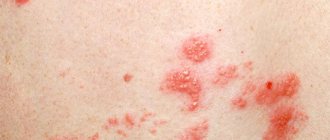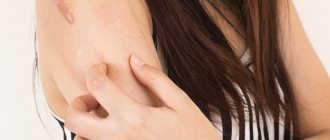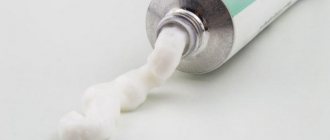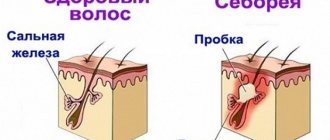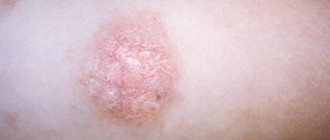Dermatovenerologist
Khasanova
Alina Rashidovna
9 years experience
Make an appointment
Pityriasis rosea has many names in medicine. It is called roseola exfoliating, Gibert's disease, pityriasis rosea. The disease belongs to the infectious-allergic category of dermatoses, is of an acute inflammatory nature with the appearance of spotty, papular, erythematous-squamous lesions. They are located mainly on the torso and on the surface of the limbs. Most often, Zhiber's pink lichen is diagnosed in women aged 20 to 40 years, as well as in adolescents. In other age categories of people, the disease is extremely rare. The peak of complaints occurs in spring and autumn during the spread of acute respiratory diseases.
Symptoms
The disease manifests itself in the form of spots on the skin.
First, several so-called maternal formations about 5 cm in size appear. Then, over the course of a week, a large number of similar spots of smaller sizes scatter throughout the body. The most vulnerable areas are the abdomen, shoulders and hips. Rashes are rare on the face and neck. All spots, both maternal and “baby” ones, have the same appearance: pink or with a yellowish tint, round in shape, flaky inside with a smooth rim. Often, apart from spots, this disease does not manifest itself in any way. Therefore, as soon as any characteristic formations are discovered on the body, you should immediately contact a special clinic to diagnose pityriasis rosea. Sometimes itching appears in the affected areas, and the lymph nodes on the neck and chin become enlarged. If a person’s immunity is severely weakened, severe fatigue, fever or general intoxication of the whole body appears. There are cases when the external manifestation differs from the usual: blisters or white nodules appear on the skin.
Information about pityriasis rosea: causes, symptoms, manifestation
Medicine does not know the exact reasons for the development of lichen deprivation in men and women. Research is being conducted in the field of the influence of herpes viruses types 6 and 7, but a clear etiological agent has not yet been identified. The causes of pityriasis rosea continue to be studied. We only know that a weakened immune system can become a trigger at any time. The causes of pityriasis rosea lie precisely in a decrease in the body's defenses due to bacterial and infectious diseases.
Symptoms and clinical picture of the disease
Due to colds, hypothermia, severe emotional states, and stress, a rash may appear on the skin. Symptoms of pityriasis rosea begin to appear from this point. The classic clinical picture is the formation of the main lesion in the form of a medallion with a diameter of 2 to 10 cm. Within 7-14 days after its appearance, the rash spreads in the form of plaques and papules of pink and yellow-brown color. They are smaller than the main lesion - their diameter can be from 0.5 to 2 cm. In appearance, the rashes can be confused with ringworm due to the scaly edge of the rashes. A few days after the rash, the spots turn pale, wrinkle and the stratum corneum cracks. The central part of the plaques remains smooth. Symptoms of pityriasis rosea may be accompanied by itching, fatigue, fever, general intoxication, and enlarged lymph nodes in the neck and chin.
Are you experiencing symptoms of pityriasis rosea?
Only a doctor can accurately diagnose the disease. Don't delay your consultation - call
Types of disease
Pityriasis rosea can have a classic appearance, when the clinical picture develops in stages in accordance with the generally accepted system - from the appearance of a “maternal” plaque to smaller rashes in the chest, back, abdomen, thighs, and on the flexor surfaces of the limbs. In the medical classification, several more forms of the disease are distinguished. Zhiber's lichen occurs:
- urticarial - characterized by the presence not of plaques, but of a rash in the form of blisters. There is severe itching. In appearance it resembles urticaria;
- vesicular - manifested by generalized rashes of vesicles with severe itching. The diameter of bubbles with clear or cloudy liquid is from 2 to 6 mm. They often form “rosettes”;
- papular - rare. It is characterized by the appearance of cavity-free formations above the surface of the skin. Small papules with a diameter of 1-2 mm;
- hemorrhagic – point hemorrhages (bleedings) occur, so the color of the plaques is darker than usual;
- follicular - rashes are grouped into round plaques of follicular papules, which can occur in parallel with classic plaques;
- unilateral;
- hypopigmented - most often occurs in people with dark or dark skin. Lichen inversus is characterized by rashes in the axillary and groin areas and in the popliteal fossae;
- asbestos-like - is extremely rare and appears on the scalp in the form of gray plaques;
- Darier's giant pityriasis rosea - the formation of large diameter plaques from 5-7 cm. In severe cases, they reach the size of the patient's palm;
- ring-shaped ring-shaped pink lichen of Vidal has an atypical location - mainly in the groin or axillary region. The rash appears ring-shaped.
Gender and age characteristics
Women, adolescents and children are susceptible to the occurrence of pityriasis rosea. Different forms of the disease affect specific groups of people. For example, the vesicular form is diagnosed more often in children and adolescents. The papular form is diagnosed in most cases in pregnant women and young children. Unilateral – occurs equally in both adults and children.
How does disease transmission occur?
Research has not given a clear answer to the question of infection. Theoretically, pityriasis rosea is transmitted by tactile contact, but this occurs extremely rarely. There must be provoking factors for infection to occur. We are talking about low immunity, past viral and infectious diseases, and colds. Relapse is possible in people with HIV, oncology and blood diseases.
Methods of infection
To date, there is no consensus on the methods of infection.
There is an assumption that the source of the disease is the herpes virus and that people with low immunity, those who have recently suffered viral infections, colds, and who are often hypothermic are primarily at risk of contracting Zhiber's disease. Women and children have a significantly higher risk of infection than men. Observations show that people over 40 years of age and infants practically do not become infected with this infection. Is this disease contagious? There is no clear answer to this question. There is an opinion that it can be transmitted through tactile contact or airborne droplets. A prerequisite for a person to become infected is the presence of a provoking factor. In practice, it has been noted that transmission of this virus from one person to another occurs infrequently.
Diagnosis of pityriasis rosea
The doctor will perform a diagnosis. At the first examination, he identifies the presence of a maternal plaque and determines the extent of the spread of rashes on the surface of the skin. Rarely, the pathology is similar to measles, eczema, rubella. The rash is similar to syphilis and is one of the signs of the disease.
Research is needed to confirm the disease. A urine and blood test will be required. If syphilis is suspected, a Wasserman test is performed. Also, a scraping is taken from the infected dermis and an examination is performed under a Wood's lamp. Diagnosing the disease in its early stages is difficult because maternal plaque is similar to other diseases. Doctors have extensive experience in treating pityriasis and will quickly identify it.
Diagnosis is prescribed by a dermatologist. Research is required to detect antibodies to the virus in a patient.
Treatment
Only a qualified specialist can determine what exactly a person has become infected with.
First a visual inspection is carried out. However, this is not enough. This type of disease looks very similar to psoriasis, rubella or syphilitic roseola. To accurately diagnose and prescribe the correct treatment for lichen, the clinic prescribes a blood and urine test, takes a scraping, and the patient undergoes a special test. Gibert's disease does not require particularly complex treatment. The disease goes away in six to nine weeks. The spots gradually fade and stop peeling. For some time, marks remain on the skin, but they also disappear over time. To alleviate the symptoms, the doctor prescribes treatment: to relieve itching - antihistamines, to reduce peeling - various ointments. Multivitamin complexes are also prescribed to increase the patient’s immunity.
In addition to drug treatment of pityriasis rosea, a hypoallergenic diet is prescribed. All foods that can cause allergic reactions are excluded from the diet: citrus fruits, eggs, red fruits, chocolate, coffee, alcohol, honey, nuts.
It is also necessary to exclude physical activity, passing exams, limit communication in order to avoid getting into stressful situations, try to wear clothes made from natural fabrics, and wash only in the shower with mild detergents. It is also forbidden to expose the affected areas of the skin to direct sunlight, as this increases the peeling process and, accordingly, impedes healing. Any self-medication can lead to undesirable consequences, so consultation with a specialist is necessary.
Help from a dermatologist in Moscow
Diagnosis and treatment of pityriasis rosea is the field of activity of a dermatologist. Depending on the form of the disease and the extent of skin damage, the patient is provided with recommendations. With lichen, the emotional and psychological background of a person is important, so promptly making a correct diagnosis allows you to quickly overcome the disease.
You can make an appointment with a dermatologist at Meditsina JSC (academician Roitberg’s clinic) by phone. You should not self-medicate. The reason is that, according to external signs, skin rashes may turn out to be differential diseases, for example, toxicerma, psoriasis, mycosis, secondary syphilis. In these cases, it is necessary to prescribe another therapy, taking into account the specific clinical picture and medical history of the patient.
How to avoid infection
Due to the fact that the nature of the occurrence of Gibert's disease has not been thoroughly studied, there are no methods to prevent this disease. The main recommendation is to monitor the state of the immune system, as it will help avoid infection.
Complications
The disease itself in most cases goes away without leaving a trace. However, sometimes complications arise in the form of eczema, staphylococcus or streptococcus; ring-shaped lichen can develop, which quite often becomes chronic and even after a few years a relapse can occur. Then treatment is done with antibiotics. To prevent such problems, we strongly recommend that you undergo comprehensive treatment in our clinic. Don't forget about your health and the health of your family!
Treatment of pityriasis rosea
To eliminate the disease, the dermatologist prescribes ointments, creams and tablets. These include:
- Acyclovir. It is used to inhibit pathogens. Experts advise applying cream or ointment every 4 hours. You can take the medicine in tablets.
- Flucinar. Reduces the formation of allergies, used for external use.
- Sinaflan. The medicine is an antihistamine, it is prescribed when lichen appears in children from 3 years of age and in adults. It is not recommended to use it for more than 7 days.
- Lokoid. Helps with allergies for women and when breastfeeding.
- Lorinden. Restores immunity, renews sleep, speeds up the healing process.
- Salicylic and zinc ointments. They have an antiseptic effect, prevent new skin rashes, and the spots dry out very quickly.
Dermatologists prescribe antiviral and antihistamine medications for therapy. If the pathology appears as a result of infection, antibacterial drugs are prescribed. Hormonal medications are prescribed in severe cases, if the disease is complicated by other chronic diseases.
For prolonged lichen, patients are prescribed antiviral drugs, it is recommended to treat stains with salicylic alcohol, as well as the use of ointments.
For symptoms of intoxication, the doctor prescribes activated charcoal as an auxiliary medicine.
The doctor prescribes antihistamines during therapy. These include Claritin, Tavegil, Loratadine, Suprastin. Taking medications is possible only on the recommendation of a doctor.
Why should you contact our clinic?
Dermatologists of the highest category
Experienced dermatologists in Moscow. Experience of specialists from 15 years.
Modern equipment
Modern equipment from the world's best manufacturers.
Expert class equipment
Ultrasound is performed using expert-class equipment manufactured by General Electric, SONY, Mindray.
Tests and ultrasound on the day of treatment
Tests, x-rays, ultrasound with interpretation, dressings on the day of treatment in Moscow.
Consultations for adults and children
A network of dermatological clinics in Moscow. Clinics near the metro.
Experienced doctors
Our experienced doctors with over 15 years of experience. Candidates of Medical Sciences.
Indirect reasons
Let's consider a group of reasons that can indirectly cause the appearance of this disease. For example, doctors believe that severe hypothermia, recent infectious diseases, or vaccination can trigger the occurrence of lichen. Also, if you were recently bitten by an insect, then perhaps it was the insect that infected you. Thus, pityriasis rosea is carried by bedbugs, lice and fleas.
Vidal's ring-shaped lichen: treatment
Let's start this chapter with the fact that if you suspect you have this disease, you should immediately contact a good dermatologist so that he can establish an accurate diagnosis and, if necessary, prescribe treatment for you. Note that if you self-medicate, this can greatly aggravate the situation and even provoke its more active development.
As for traditional treatment, it consists of the following elements:
- A special diet that consists of an abundance of dairy products, plenty of vegetables and herbs, as well as foods that contain a lot of iron. Doctors also highly recommend consuming honey daily. During the diet, you should not add salt to your food.
- A special sleep regimen, which implies that a sick person should get enough sleep every day. In addition, he should not be overtired and too nervous, because this can provoke the progression of the disease.
- Taking special medications that can suppress the development of the disease. If antihistamines do not provide adequate help, then the patient is prescribed antidepressants, which make it easier to tolerate the symptoms of the disease.
- Mandatory intake of ascorbic acid and vitamins A and B.
- Careful and constant adherence to all rules of hygiene, as well as the use of antiseptics in all cases where necessary.
- Taking hormonal drugs. They are not prescribed to everyone and not always, but in some cases it is simply impossible to influence the treatment of diseases without the intervention of hormonal drugs.
- A complete rejection of synthetic clothing, as well as a ban on wearing woolen fur items.
Prevention of pityriasis rosea
- regular walks;
- reduce consumption of fatty foods and foods containing dyes;
- include multivitamins in your diet only on the recommendation of a dermatologist;
- change bed linen and clothes regularly;
- Perform water procedures regularly;
- undergo preventive examinations;
- avoid stress;
- Do not use hard washcloths that irritate the skin.
The diet should be balanced; our doctors will recommend that the patient monitor the amount of carbohydrates and proteins. It is better to include fermented milk products, cereals, bread, and lean beef in the menu. Vegetables and berries are useful for treating the disease.
Definition
Let's start with the fact that Vidal's lichen is a limited neurodermatitis that belongs to the category of pityriasis rosea. Lichen annulare is not inherently dangerous to humans, but the fact is that some manifestations of the disease can cause some discomfort in a person.
We will also explain what neurodermatitis is. This is a skin disease that recurs over time. It is neurogenic and allergic in nature.

